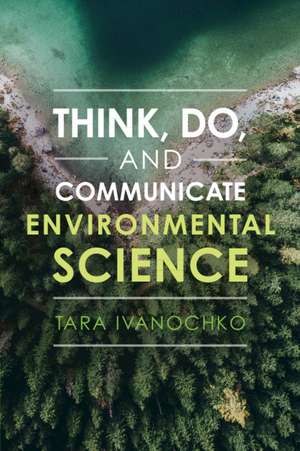Think, Do, and Communicate Environmental Science
Autor Tara Ivanochkoen Limba Engleză Paperback – 12 mai 2021
| Toate formatele și edițiile | Preț | Express |
|---|---|---|
| Paperback (1) | 283.03 lei 6-8 săpt. | |
| Cambridge University Press – 12 mai 2021 | 283.03 lei 6-8 săpt. | |
| Hardback (1) | 442.27 lei 6-8 săpt. | |
| Cambridge University Press – 12 mai 2021 | 442.27 lei 6-8 săpt. |
Preț: 283.03 lei
Nou
Puncte Express: 425
Preț estimativ în valută:
54.16€ • 56.69$ • 45.08£
54.16€ • 56.69$ • 45.08£
Carte tipărită la comandă
Livrare economică 31 martie-14 aprilie
Preluare comenzi: 021 569.72.76
Specificații
ISBN-13: 9781108437578
ISBN-10: 1108437575
Pagini: 250
Dimensiuni: 230 x 150 x 15 mm
Greutate: 0.34 kg
Editura: Cambridge University Press
Colecția Cambridge University Press
Locul publicării:Cambridge, United Kingdom
ISBN-10: 1108437575
Pagini: 250
Dimensiuni: 230 x 150 x 15 mm
Greutate: 0.34 kg
Editura: Cambridge University Press
Colecția Cambridge University Press
Locul publicării:Cambridge, United Kingdom
Cuprins
Foreword Ralph Keeling; Introduction; 1. Reading papers to find the science, not the answer; 2. Communicating science visually; 3. Matching scales and processes; 4. Collecting environmental data; 5. Writing research questions; 6. Aligning your question with your data; 7. Working with environmental data; 8. Isolating individual signals from a composite dataset; 9. Differentiating signals from noise; 10. Characterizing your data; 11. Comparing datasets; 12. Developing simple environmental models; 13. Writing a science proposal; 14. Writing an abstract; Appendix: Working in Excel; Glossary; Epilogue; Index.
Recenzii
'This would be a good textbook for an experiential learning course or a helpful project guide. Institutions with environmental science teaching programs would be especially well advised to acquire the volume, and it may also be of interest to general readers and advanced homeschoolers … Highly recommended.' R. C. Hedreen, Choice Magazine
'a valuable accessory resource for both upper-level undergraduate and graduate courses in ecological or environmental science' Christopher J. Whelan, The Quarterly Review of Biology
'a valuable accessory resource for both upper-level undergraduate and graduate courses in ecological or environmental science' Christopher J. Whelan, The Quarterly Review of Biology
Notă biografică
Descriere
A student's guide to setting up and conducting environmental research projects, including how to analyze data and write research proposals.
